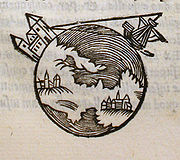
De sphaera mundi
Encyclopedia

Astronomy
Astronomy is a natural science that deals with the study of celestial objects and phenomena that originate outside the atmosphere of Earth...
written by Johannes de Sacrobosco
Johannes de Sacrobosco
Johannes de Sacrobosco or Sacro Bosco was a scholar, monk, and astronomer who taught at the University of Paris and wrote the authoritative mediaeval astronomy text Tractatus de Sphaera.-Origins:Although described as English, his birthplace is unknown because Sacrobosco is...
(John of Holywood) c. 1230. Based heavily on Ptolemy
Ptolemy
Claudius Ptolemy , was a Roman citizen of Egypt who wrote in Greek. He was a mathematician, astronomer, geographer, astrologer, and poet of a single epigram in the Greek Anthology. He lived in Egypt under Roman rule, and is believed to have been born in the town of Ptolemais Hermiou in the...
's Almagest
Almagest
The Almagest is a 2nd-century mathematical and astronomical treatise on the apparent motions of the stars and planetary paths. Written in Greek by Claudius Ptolemy, a Roman era scholar of Egypt,...
, and drawing additional ideas from Islamic astronomy
Islamic astronomy
Islamic astronomy or Arabic astronomy comprises the astronomical developments made in the Islamic world, particularly during the Islamic Golden Age , and mostly written in the Arabic language. These developments mostly took place in the Middle East, Central Asia, Al-Andalus, and North Africa, and...
, it was one of the most influential works of pre-Copernican
Copernican Revolution
The Copernican Revolution refers to the paradigm shift away from the Ptolemaic model of the heavens, which postulated the Earth at the center of the galaxy, towards the heliocentric model with the Sun at the center of our Solar System...
astronomy in Europe.
Reception
Sacrobosco's De sphaera mundi was the most successful of several competing thirteenth-century textbooks on this topic. It was used in universitiesUniversity
A university is an institution of higher education and research, which grants academic degrees in a variety of subjects. A university is an organisation that provides both undergraduate education and postgraduate education...
for hundreds of years and the manuscript
Manuscript
A manuscript or handwrite is written information that has been manually created by someone or some people, such as a hand-written letter, as opposed to being printed or reproduced some other way...
copied many times before the invention of the printing press
Printing press
A printing press is a device for applying pressure to an inked surface resting upon a print medium , thereby transferring the ink...
; hundreds of manuscript copies have survived. The first printed edition appeared in 1472 in Ferrara
Ferrara
Ferrara is a city and comune in Emilia-Romagna, northern Italy, capital city of the Province of Ferrara. It is situated 50 km north-northeast of Bologna, on the Po di Volano, a branch channel of the main stream of the Po River, located 5 km north...
, and at least 84 editions were printed in the next two hundred years. The work was frequently supplemented with commentaries on the original text. The number of copies and commentaries reflects its importance as a university text.
Content

The universe as a machine
Sacrobosco spoke of the universe as the machina mundi, the machine of the world, suggesting that the reported eclipse of the Sun at the crucifixion of Jesus was a disturbance of the order of that machine. This concept is similar to the clockwork universe analogy that became very popular centuries latter, during the EnlightenmentAge of Enlightenment
The Age of Enlightenment was an elite cultural movement of intellectuals in 18th century Europe that sought to mobilize the power of reason in order to reform society and advance knowledge. It promoted intellectual interchange and opposed intolerance and abuses in church and state...
.
Spherical Earth
Though principally about the universe, De sphaera contains a clear description of the EarthEarth
Earth is the third planet from the Sun, and the densest and fifth-largest of the eight planets in the Solar System. It is also the largest of the Solar System's four terrestrial planets...
as a sphere which agrees with unanimous opinion during the Middle Ages, in contrast to statements of 19th- and 20th-century historians that most medieval scholars thought the Earth was flat
Myth of the Flat Earth
The myth of the Flat Earth is the modern misconception that the prevailing cosmological view during the Middle Ages saw the Earth as flat, instead of spherical....
.

